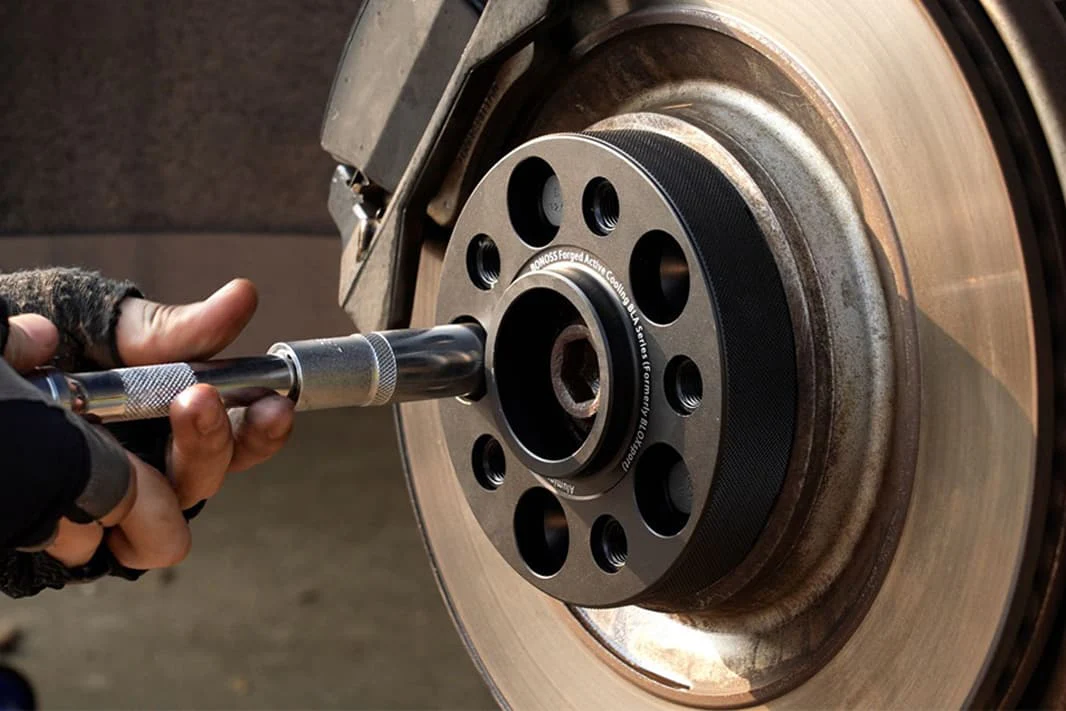Wheel spacers are aftermarket components used to modify the position of a vehicle’s wheels relative to its hub. By placing the spacer between the wheel and the hub, they effectively push the wheel outwards, increasing the track width of the vehicle. This modification is popular among car enthusiasts for several reasons, including improved aesthetics, better handling, and the ability to fit larger wheels or tires without rubbing against the suspension or bodywork.
The question many drivers and enthusiasts ask is, “Are wheel spacers legal?” This is a crucial consideration, as vehicle modifications are governed by strict safety and compliance regulations, particularly in regions like Queensland. While wheel spacers can offer tangible benefits, their legality is not always clear-cut. Understanding the legal landscape and potential consequences is essential before making any modifications.
In this article, we’ll explore whether wheel spacers are legal in Queensland and provide guidance for enthusiasts looking to modify their vehicles responsibly and within the bounds of the law.
Legal Status of Wheel Spacers in Queensland
In Queensland, the legality of wheel spacers is governed by a range of road safety and vehicle modification laws. The state adheres to the Australian Design Rules (ADRs), which set out strict guidelines for vehicle modifications to ensure safety, stability, and performance. When it comes to wheel spacers, the general rule is that they are legal under certain conditions, but modifications must comply with specific requirements.
The key regulation to be aware of is that any modification made to a vehicle must not compromise its safety or roadworthiness. Wheel spacers can affect factors such as suspension geometry, handling, and brake efficiency, which is why the Queensland government imposes guidelines for their use.
One important consideration is the amount of spacing that can be added. According to the regulations, wheel spacers that alter the track width by more than 25mm per axle are subject to more scrutiny. Any modification that increases the track width beyond this limit could require an engineer’s certification to ensure that the changes do not negatively impact the vehicle’s performance or safety features.
Additionally, if wheel spacers are used in a way that causes the wheels to protrude beyond the body of the vehicle, it can be deemed illegal. This is because the law prohibits any vehicle from having wheels that extend beyond the body or fenders, as it may pose a risk to other road users.
Why Are Wheel Spacers Regulated?
Wheel spacers are regulated due to their potential impact on a vehicle’s safety, performance, and handling characteristics. While they can enhance the aesthetics and functionality of a car, they also introduce certain risks that need to be carefully considered, which is why authorities impose strict guidelines for their use.
One of the primary concerns with wheel spacers is their effect on suspension geometry. By moving the wheels outward, the spacer changes the way the suspension components interact with the road. This alteration can lead to uneven wear on tires, reduced traction, and unpredictable handling, especially during high-speed cornering or emergency maneuvers. These changes can compromise the vehicle’s stability, which is why modifications that impact the suspension system are closely regulated.
In addition to suspension concerns, wheel spacers can also affect the braking system. When the track width is altered, the forces applied to the brake components during driving can change. This might reduce braking efficiency or place additional stress on the brake system, increasing the risk of brake fade or failure, particularly in high-performance vehicles or under heavy load conditions.
Another key factor is the potential for wheel clearance issues. If wheel spacers push the wheels too far outward, they may cause the tires to rub against the vehicle’s fenders, suspension components, or even the wheel well. This can lead to damage to the vehicle and the tires themselves, as well as increase the risk of a blowout or other dangerous failures on the road.
The regulations surrounding wheel spacers exist to ensure that vehicles remain roadworthy and safe for both the driver and other road users. By controlling the extent to which modifications are allowed, authorities aim to minimize these risks and maintain the integrity of the vehicle’s design and performance.
Permitted Modifications and Compliance
When modifying a vehicle in Queensland, it is crucial to ensure that any changes made are compliant with the state’s road safety regulations. While wheel spacers can be legal, they must meet specific criteria to avoid compromising vehicle safety and performance. Here’s an overview of the types of wheel modifications that are typically permitted and the standards required for compliance.
The Queensland Government follows the National Code of Practice for Light Vehicle Modifications (NCOP), which outlines the guidelines for all vehicle modifications, including wheels and suspension. For wheel spacers, one of the key considerations is the amount by which the track width is altered. As previously mentioned, wheel spacers that increase the track width by more than 25mm per axle may require additional approval, such as certification from an accredited engineer, to ensure they do not adversely affect the vehicle’s handling, stability, or safety.
To comply with the regulations, wheel spacers should also be installed correctly. This includes ensuring that they are made from high-quality materials and are compatible with the vehicle’s existing wheel and hub setup. It is important that spacers are fitted in a way that maintains the integrity of the wheel attachment, preventing any risk of the wheel detaching or becoming unstable while driving.
Another critical factor for compliance is that the modification must not cause the wheels to protrude beyond the body of the vehicle. The wheels should remain within the vehicle’s fender flares, as any protrusion beyond this point could be considered illegal. This regulation exists to ensure that the vehicle does not pose a danger to pedestrians, cyclists, or other vehicles on the road.
For enthusiasts considering modifications to their wheels, it’s also important to remember that any other changes to the vehicle, such as alterations to the suspension, tire size, or brake system, must be considered in tandem with the wheel spacers. These changes can further affect the vehicle’s performance and must be done within the legal framework to ensure overall compliance.
Ultimately, ensuring that wheel spacers and other vehicle modifications meet the required standards is essential for maintaining roadworthiness and avoiding fines or penalties. If in doubt, consulting with an approved engineer or a professional who understands Queensland’s vehicle modification laws is a wise step to guarantee compliance.
Penalties for Non-Compliance
Failure to comply with Queensland’s vehicle modification laws, including the use of illegal wheel spacers, can result in serious penalties. These penalties are in place to ensure that all vehicles on the road meet safety standards and do not pose a risk to the driver, passengers, or other road users.
One of the primary penalties for using non-compliant wheel spacers is a fine. The exact amount can vary depending on the severity of the violation and whether the modification compromises the vehicle’s safety. For example, if wheel spacers push the wheels beyond the vehicle’s fenders or alter the track width beyond the permissible limit, the driver could face a fine under the Vehicle Standards. The fines can be substantial, especially if the vehicle is found to be in breach of multiple safety requirements.
In addition to fines, vehicles that are deemed non-compliant may be ordered to undergo an inspection. This inspection could lead to further penalties or the requirement for the vehicle to be returned to its original, legal configuration. If the modification is deemed particularly unsafe, the vehicle could even be deregistered or its registration could be suspended until the issue is rectified.
For individuals who regularly modify their vehicles, repeated non-compliance can lead to more severe consequences. In some cases, if a driver is found to be repeatedly using illegal modifications, including improper wheel spacers, they may face higher fines, points on their license, or even restrictions on future modifications.
Additionally, insurance companies may refuse to cover a vehicle that has been modified illegally, leaving the owner financially exposed in the event of an accident. This is because vehicle modifications that do not meet legal standards can increase the risk of accidents or mechanical failures. Without the proper certification, the vehicle may no longer be deemed roadworthy by insurers, leading to costly out-of-pocket expenses for the driver.
Alternatives to Wheel Spacers
For car enthusiasts who want to achieve a wider stance or enhance the appearance of their vehicle without violating legal guidelines, there are several alternatives to wheel spacers that are both legal and safe. These alternatives can help achieve similar effects while ensuring compliance with Queensland’s vehicle modification regulations.
One of the most common alternatives is offset wheels. Instead of using wheel spacers to push the wheels outward, offset wheels are designed with an altered mounting surface to achieve the desired track width. These wheels can be custom-made or purchased in aftermarket sizes, providing an ideal solution without the need for spacers. Offset wheels come in various sizes and styles, allowing enthusiasts to fine-tune the fitment of their vehicle while maintaining safety and compliance.
Another option is to lower the vehicle’s suspension. By adjusting the ride height, you can change the stance of the car, giving it a more aggressive or performance-oriented appearance. Lowering the suspension may also improve handling and stability, though it’s essential to ensure that the modifications stay within legal limits and don’t interfere with the vehicle’s safety or roadworthiness. Suspension modifications must be done carefully to avoid issues with ground clearance, suspension geometry, or alignment.
For those looking to increase the track width without using spacers, wider tires can be a viable solution. By opting for tires with a larger footprint, you can achieve a broader stance and improve traction, handling, and cornering. However, it is important to choose tire sizes that are compatible with the vehicle’s wheel arches and suspension components. As with any modification, make sure the changes comply with Queensland’s vehicle standards, especially in relation to tire clearance and overall safety.
Additionally, performance suspension kits that allow for greater control over the geometry of the suspension system can also provide a similar effect to wheel spacers. These kits are designed to improve handling, reduce body roll, and allow for more precise tuning of the vehicle’s stance without compromising safety or stability.
By choosing one of these alternatives, car enthusiasts can achieve the desired aesthetic or performance modifications while remaining within the legal framework. It is always recommended to consult with a professional or vehicle engineer before making any major modifications, ensuring that the chosen solution adheres to local laws and does not negatively affect the vehicle’s safety or performance.
Conclusion
Wheel spacers can be an appealing modification for car enthusiasts looking to enhance their vehicle’s appearance or handling, but it’s important to understand the legal landscape surrounding their use in Queensland. While wheel spacers are not outright banned, they must comply with strict regulations to ensure the safety, performance, and roadworthiness of the vehicle. Modifications that alter the track width, cause the wheels to protrude beyond the body, or compromise the suspension or braking system may be deemed illegal.
To avoid penalties, fines, or complications with insurance, it’s essential to stay informed about the legal requirements for wheel spacers and other modifications. For those looking for alternative ways to achieve a wider stance or improved performance, options like offset wheels, suspension adjustments, wider tires, or performance suspension kits can offer safe and compliant solutions. Always remember to consult with experts or professionals to ensure that any modification adheres to Queensland’s vehicle standards.
Ultimately, modifying a vehicle can be a rewarding and enjoyable experience, but it should always be done with safety, legality, and compliance in mind. By understanding the regulations and exploring legal alternatives, enthusiasts can enhance their vehicles without risking penalties or compromising their safety.











